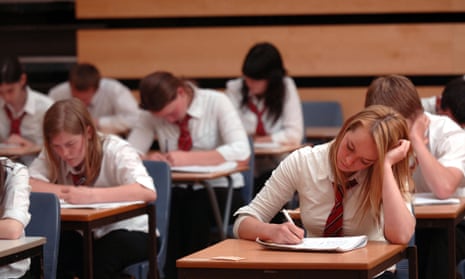Only eight out of the 20 academy chains responsible for more than 240 individual schools examined by the Department for Education are producing above average results at GCSE or equivalent, according to the first systematic government attempt to grade their performance.
The figures also show that some schools, especially within London, are improving faster than academy chains, but many schools in deprived towns in the north are falling back.
The statistics will fuel the election debate over the extent to which bodies such as academies and free schools are really critical to the performance of schools in general.
The Department for Education tables, published following lobbying by the schools minister David Laws, show some academy chains such as Ark and Harris improving results over the past five years. But the data, taking into account the prior attainment of students, shows only seven of the 20 chains measured have schools that are improving at a faster rate than other equivalent schools.
The figures are likely to put pressure on the government to allow the inspection of academy chains by Ofsted, something the education secretary Nicky Morgan has resisted.
In the fast changing education landscape, academy chains have become the latest feature, as a sponsoring body takes over the running of a group of schools in a similar way that a local authority used to be responsible for the oversight of schools in its geographical locality.
Laws hopes the new tables, revealed on Monday to the education selection committee following some coalition debate, will represent a new permanent feature on the education landscape and shine a light not just on underperforming local authorities, but underperforming chains of academies.
The data again underlines the extent to which improvements are being driven in inner city London – Hackney, Greenwich, Islington, Lambeth, Merton, Enfield, Waltham Forest – are scoring very high improvement marks, even alongside the best performing academy chains such as Harris.
By contrast the levels of improvement in the urban north and Midlands – Redcar, Blackpool, Barnsley, Bradford, Oldham and Salford – all show slower or no improvement,
A Liberal Democrat source said: “It is no secret that we want to make the academies more accountable and we have been pushing for Ofsted to be able to inspect schools. We want as much information about the performance of academies and local authorities published so we can get the debate away from the Conservative focus on the type of school to the quality of a school. There can be no way that we mollycoddle or protect badly performing chains of academies.”
In terms of improvement at GCSE key stage 4 and equivalent over the past five years, taking into account the background of the children, the tables suggest the best performing chain is Ark Schools (24.7%), followed by United Learning (12.2%), Harris Federation (11.3%), and then the Diocese of Westminster Academy Trust (9.2%).
The chains with the worst outcomes in terms of improvement are UCAT (-20.6%), Greenwood Dale Foundation Trust (-19.9%), the School Partnership Trust Academies (-13.5%), the CfBT Schools Trust (-12.6%) and Diverse Academies Trust (-6.3%). All five are improving more slowly than the average,
The data attempts not simply to provide a measure of attainment by pupils or improvement on attainment, but also take into account prior attainment of the pupil,. The data only applies to chains that have at least five schools.
The Department for Education stresses they are testing the system of measurement and it will be open to refinement. There is also dispute over the extent to which the performance of academy chains should be ranked alongside the performance of schools within local authorities.
Some argue the role of a chain board and a local authority is so different as not to be comparable.
The coalition has been heavily criticised for failing to publish information on the performance of academy chains most recently by the education select committee, prompting disagreements within the coalition about how to respond.
The select committee recommended: “The progress and results of each multi-academy trust (of more than three academies) be published on a chain-by-chain basis as well as by individual academy.
“In the interests of accountability and transparency, the performance and other data relating to academy chains, should be published broken down by school and trust”, the committee added.
It is estimated over half of all academies are in formal collaborative arrangements intended to share expertise providing challenge and improving standards
The Department for Education statisticians said: “To date there has been no systematic approach to comparing the performance of these organisations. There is a growing need to show the impact that academy chains and local authorities have on school performance both in aggregate and relative to each other.”

Comments (…)
Sign in or create your Guardian account to join the discussion